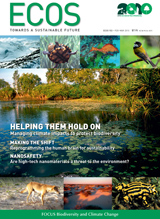
|
Published:
Nanosafety and the environment
Naturally occurring nanoparticles are all around us – in soil, water and the air we breathe. With scientists now able to engineer innovative materials at this incredibly small atomic scale, some potential environmental and health risks are emerging that will require further research.

|
|
Virtual view of a carbon nanotube. Nanotubes are being woven into new types of nanomaterial adding to the hundreds of types of nano-products now available. Credit: iStockphoto
|
While nanotechnology opens up an array of new solutions to global sustainability challenges, such as more efficient energy and water use, concerns are being raised about the potential risks to humans and the environment associated with some engineered nanomaterials.1
In August 2009, the US Project on Emerging Nanotechnologies2 listed more than 1000 entries in its inventory of nanotechnology products. They include consumer products such as sunscreens, cosmetics, wrinkle and odour resistant fabric, and germ-fighting white goods containing nanosilver, as well as industrial products like wood sealers and coatings for buildings or furniture.
Nanomaterial particles can be present as single particles or in clusters and with spherical, tubular or irregular shapes. Long hollow filaments, known as carbon nanotubes, have been engineered for use in novel textile structures and other applications.
In 2008, a paper published in the journal Nature Nanotechnology warned that certain types of carbon nanotubes may have asbestos-like properties and that nanomaterials can cause damage to cells on the other side of a cellular barrier.3
Dr Maxine McCall from CSIRO – which has established a research program to investigate the effects of nanomaterials on human health and the environment – says there is currently not enough known about the properties of many nanomaterials to inform our risk assessment.
‘There are significant gaps in our knowledge about their potential side effects for health and the environment,’ she says.
‘We need to have the same respect for nanotubes as for asbestos, even though not all nanotubes will turn out to be dangerous.’
Eco-applications
In the environment, nanotechnologies are being used in applications such as water and air purification, pollution detection and solar energy production.
Professor Terry Turney of Monash University’s Centre for Green Chemistry heads a group investigating the use of nanomaterials to make better plastics. He is also interested in their use as sensors to monitor the flow of energy and water.
‘We are getting to the point where you can print sensors very cheaply – you could put one in every tap to measure the amount of water used and water quality for example,’ he says.
Then there are the so-called ‘active’ nanomaterials, which respond to changes in the environment to produce a desired effect. For example, coatings used to insulate buildings can switch from being heat-absorbing to heat-reflecting at a certain temperature.
Another application is embedding intelligence into packaging – for example, instead of food products having to carry a use-by date, biosensors on the packaging could sense the condition of the content and indicate whether or not it was safe to eat.

|
|
Lightweight ‘nanoyarn’, many times stronger than steel, being spun from carbon nanotubes. Credit: CSIRO
|
Soil and water investigations
The increased use of nanomaterials in industrial and consumer products means that they are likely to show up in liquid and solid wastes, and in soils.
Professor Mike McLaughlin of CSIRO Land and Water heads a team at Adelaide University investigating the fate and behaviour of nanomaterials in soils and their potential effects on soil organisms.
With the push to re-use urban industrial wastes, many end up being recycled back on land, but this may not be appropriate for materials containing silver nanoparticles, for example. The CSIRO researchers have found that silver nanoparticles – used in products for their antibacterial properties – can release silver ions, which are potentially highly toxic to soil organisms.
‘Our research is showing that nano-materials don’t necessarily stay in that form for long. Under certain conditions they can dissolve or aggregate,’ says Prof McLaughlin.
Because the research is still at an early stage, it is too soon to say whether soils have been contaminated. Eventually however, data from this research will help regulatory authorities develop guidelines for disposing of nanomaterials in the environment.
In the same team at CSIRO Land and Water, Dr Nicola Rogers is investigating the potential impacts of nanoparticles in the aquatic environment.
She says the key questions the group is trying to address is whether nanoparticles are toxic and whether they pose a risk different to that posed by the same material at a larger scale.
One of her initial findings was that zinc oxide nanoparticles – used in ‘transparent’ zinc sunscreens for UV protection – are toxic to aquatic organisms. It appears that the uncoated soluble zinc oxide nanoparticles generate significant concentrations of zinc ions in solution. Dr Rogers emphasises that it is the zinc ions, not particulate zinc, that are responsible for the observed toxicity.
‘Further research is needed to understand the role of solubility and particle chemistry on the potential environmental effects of other nanoparticles, such as silver and cerium dioxide (used as a fuel catalyst),’ says Dr Rogers.
So far, the CSIRO team has carried out all nanomaterials testing in the laboratory. The next step will be to test the materials in natural aquatic systems.

|
|
Scientists say we need to know more about some nanomaterials to fully understand their health and environmental risks. Credit: iStockphoto
|
Uncertainty around risks
Many of the nanomaterials used in products sold in Australia are nano-forms of existing chemicals and can be legally introduced and used without notification, even though they have not been assessed for their novel nano-scale properties.
A 2008 review of the regulations covering nanomaterials identified a number of issues that need addressing to ensure Australia’s regulatory frameworks can better handle the risks posed by nanotechnology in the future.4
The National Industrial Chemicals Notification and Assessment Scheme (NICNAS) is currently consulting on how it should adjust its assessment and notification procedures to take account of the uncertain risks posed by industrial nanomaterials. The public consultation closed on 12 February 2010.5
NICNAS says there is no definitive data on the levels of industrial nanomaterials in Australia as there is no legal requirement on businesses to report these volumes. Voluntary surveys in 2006 and 2008 returned only a low response and revealed more about the types of products than the volume of industrial nanomaterials on the market.
Friends of the Earth (FOE) has called for a moratorium on research, development and production of synthetic nano-products while regulations are developed to protect the health and safety of workers, the public and the environment from any harmful impacts of nanotechnology.
FOE spokesperson, Georgia Miller, says as well as the immediate toxicity issue of nanoparticles – such as the issue of silver used in consumer products ending up in wastewater – there is the issue of the broader environmental footprint of nanotechnology.
‘Although the environmental benefits are often promoted as reasons we should be enthusiastic about nanotechnology, the process is very energy and water intensive and can often produce toxic chemicals,’ she says.
However, Maxine McCall believes that nanotechnology’s potential benefits outweigh its risks.
‘The OECD has recognised the huge potential for nanotechnologies and also the need for information on their impact on the environment and human health,’ she says.
‘It is coordinating an international program to generate this information for a representative set of 14 manufactured nanoparticles.’
Australia is contributing to the study. Dr McCall is coordinating the Australian consortium, testing zinc oxide, cerium oxide and silver nanoparticles. She says the program will deliver ‘much of the information we need to safely develop and regulate nanoparticles’.
More information: |
The Project on Emerging Nanotechnologies, www.nanotechproject.org |
Nanosafe Australia, |
1 Nanoparticles are routinely defined as particles with sizes between about 1 and 100 nanometres that show properties not found in bulk samples of the same material. As a guide to the relative size of nanomaterials, a human hair is roughly 80 000 nanometres wide, while a DNA molecule is about 2 nanometres wide.
2 Funded by the Woodrow Wilson International Centre for Scholars and the PEW Charitable Trusts.
3 Poland et al. (2008) ‘Carbon nanotubes introduced into the abdominal cavity of mice show asbestos-like pathogenicity in a pilot study’ Nature Nanotechnology 3, 423–428, doi:10.1038/nnano.2008.111.
4 ‘Review of the Possible Impacts of Nanotechnology on Australia’s Regulatory Framework (The Monash Report)’, www.innovation.gov.au/Industry/Nanotechnology/Documents/MonashReport2008.pdf
5 National Industrial Chemical Notification and Assessment Scheme (NICNAS), www.nicnas.gov.au/Current_Issues/Nanotechnology.asp



